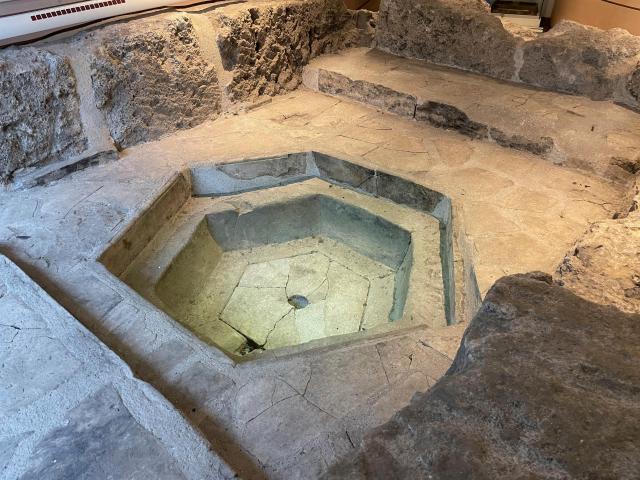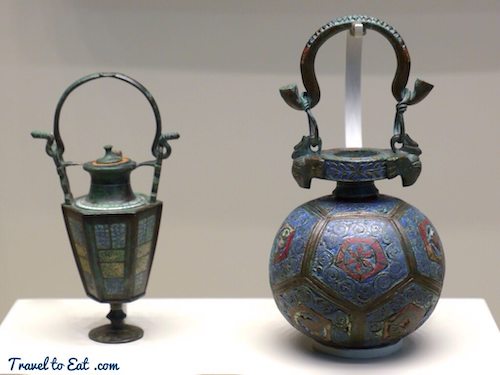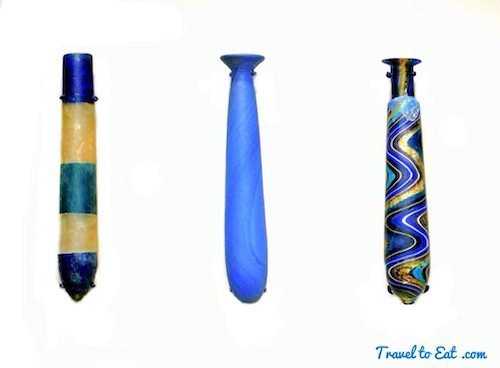Because they were most likely made by numerous people scattered over a large area, the construction techniques may have had some variations. It sounds like there are two larger holes of equal diameter on opposite faces on many or most dodecahedrons. The smaller holes are the ones with non-uniform diameters. The two large equal-size holes may be from the casting process, while the smaller holes were cut after the mold was broken away from the dodecahedron. The Icosahedron also has the two large equal-diameter holes which may be a necessary part of the casting process.
At least one hole is necessary to pick out the core of casting matrix from the inside.
Edit: at least, that is the case with this type of lost wax casting - there are casting methods for hollow forms that don’t require a core, but these would not have been made that way.
Dodecahedrons weren’t the only cool polygonal thing the Gallo Romans created. The image below is a Gallo Roman fountain in Rouen, France.
Obviously, this must be where they would recharge their dodecahedrons when they were out of juice, right? ![]()
They also designed geometric floor mosaics.
This one is from the Château de Marigny in Fleurville, eastern France.
Not sure about that. How would they fit the pentagonal base into a hexagonal socket?
Green Lantern’s ring and power battery aren’t the same shape either! ![]()
Instead of sleeping the other night I was ruminating over this whole thing. They are only found in the Germanic areas of the empire, and what’s one of the great cultural differences between those areas and the Mediterranean areas of the empire? Drinking beer and/or mead instead of wine!
My theory, or WAG really, is they were thought to impart a pleasing metallic flavour to those drinks, so were thrown into the mugs or steins when, or after, serving. The knobs keep them off the bottom regardless of which way they are thrown in, and the holes allow for maximum contact surface area with the drink. And being invisible when in use, there’s no point in decorating them. Size wouldn’t matter much, nor would the diameter or dimensions of the holes.
Have there been any investigations on substances on them, maybe traces caught in the angles where the knobs join?
Points in opposition might be why only that exact shape instead of, say, a cube (more surface area?), and why only bronze (other metals didn’t taste right)?
Anyway, that was my late-night fancy!
With force.
Not true. They are found in the Gallo- and Britano-Roman areas as well.
Romans drank beer. It wasn’t considered as classy as wine, but they definitely drank a lot of beer - Roman soldiers brought the habit back from Gaul, Germania and Egypt (and they also imported it from there)
Another might be using candles instead of oil lamps.
Candles have been mentioned over 50 times already.
I think it’s true that historically, pretty much anywhere you get bread, you get beer
Although there has been at least one dodecahedron found with traces of wax on it, there are a lot of arguments against why they make poor candleholders, some of which are mentioned earlier in this thread. Also, objects more easily recognizable as candlesticks are found in the Gallo Roman regions. The one in the image is of Roman design, found in Lincolnshire, England.
No, see, the dodecahedrons are candle-holders, but that thing is actually a tool for making spear-tips.
The idea that they are a stand for some object that:
- came in a variety of sizes
- needed to be kept upright
- was somewhat tapered at the bottom
- didn’t stand up well on its own
is so tempting
I just came across this image. It is a 70-100 CE Gallo Roman aryballos (oil/perfume bottle) in the Getty Museum. It is made of enameled bronze. I have not found anything about the artifact’s provenance. The body of the bottle has a dodecahedron design. I would love to see close-up images of the ornamentation within each pentagonal face.
Also, is that dodecahedral pattern purely surface detailing, or is it in any way structural (like, the sphere being constructed from pentagonal panels)? Probably just surface: It’s easier to make a sphere qua sphere than to make the panels and get them to fit together right… but if it is fitted together, that’s definitely interesting.
To me, at least, it looks like a surface design on a solid bronze vessel. I have seen many comments that Gallo Roman dodecahedrons have never been found depicted in art. This may not be a sculpture or mosaic showing someone using or interacting with a knobbed Gallo Roman dodecahedron, but it does give an example of the general dodecahedral form being used in an artistic manner.
That perfume holder might fit well on top of one of the dodecahedrons. Maybe they were used to hold small spherical objects so they won’t roll. If it is a small object, then use one of the small holes. The nibs prevent rolling in addition to providing more holding space for larger objects.
Then, since people who have it are already predisposed to thinking of it as a holder, one person may have tried to use it as a candle holder, which explains the one instance of wax. Only it didn’t work out very well so it didn’t catch on.
I like that idea. If they ever find a dodecahedron and a round vessel together, it could help support that as a theory. A matched pair, like a dodecahedron found with a dodecahedron-decorated vessel, would even be better.





